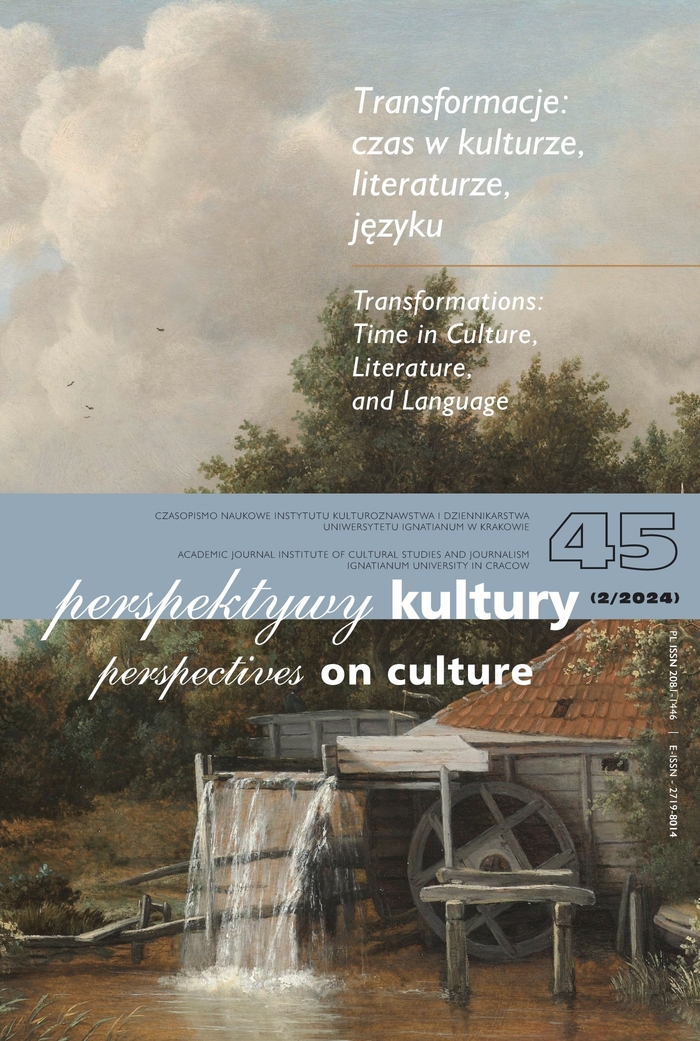Joseph Conrad – A Time-Lord
Abstract
Conrad’s fiction manages the temporal dimension in highly innovative ways. Conrad was ahead of his time in employing such devices as delayed decoding, flashbacks, time-shifts, as well as by enveloping his characters in temporal loops or a timeless space. In his works, time defies the laws of physics, allowing him to create an idiosyncratic space-time continuum.
References
References to Conrad’s works are to the Cambridge Edition of the Works of Joseph Conrad. All the references are abbreviated as follows: “Heart of Darkness,” HD; Lord Jim, LJ; Notes on Life and Letters, NLL; A Personal Record, PR; The Secret Agent, SA.
Conrad, J. (1972). Nostromo. A Tale of the Seaboard, ed. N. Sherry. London: Dent, abbreviated N.
Conrad, J. (1975). Tomorrow. In: The Nigger of the ‘Narcissus’,Typhoon and other Stories. Harmondsworth: Penguin Books, 333–359, abbreviated T. Alford, C.F. (2016). Levinas, trauma, and God: Does Emmanuel Levinas idealize trauma? Retrieved from: https://www.traumatheory.com/tag/cathy-caruth/ (access: 10.09.2023).
Blanco, M. del Pilar & Peeren, E. (2013). Intorduction: Conceptualizing Spectralities. In: M. del Pilar Blanco & E. Peeren (eds.), The Spectralities Reader. Ghosts and Haunting in Contemporary Cultural Theory. London, New York: Bloomsbury, 1–27.
Bernstein, J.A. (2012). “No Audible Tick”: Conrad, McTaggart, and the Revolt against Time. The Conradian, no. 1(37), 32–45.
Caruth, C. (1995). Trauma and Experience: Introduction. In: Trauma. Explorations in Memory. Baltimore and London: The Johns Hopkins UP, 3–12. Derrida, J. & Stiegler, B. (2013). Spectrographies. In: M. del Pilar Blanco & E. Peeren (eds.), The Spectralities Reader. Ghosts and Haunting in Contemporary Cultural Theory. London, New York: Bloomsbury 37–51.
Gillihan, S.J. (2016). 21 Common Reactions to Trauma. Retrieved from: https:// www.psychologytoday.com/us/blog/think-act-be/201609/21-common-rea- ctions-trauma (access: 12.09.2023).
Kertzer, J.M. (1979). Joseph Conrad and the Metaphysics of Time. Studies in the Novel, no. 3 (11), 302–317.
Knowles, O. & Moore, G. (2000). Oxford Reader’s Companion to Conrad. Oxford, New York: Oxford UP.
Najder, Z. (1997). Conrad in Perspective. Essays on Art and Fidelity. Cambridge: Cambridge UP.
Najder, Z. (1996). Wstęp. In: J. Conrad-Korzeniowski, Lord Jim. Wrocław, Warszawa, Kraków: Zakład Narodowy Imienia Ossolińskich, V–XCVI.
Stolorow, R.D. (2015). Trauma Destroys Time. Retrieved from: https://www. psychologytoday.com/us/blog/feeling-relating-existing/201510/trauma-destroys-time (access: 07.09.2023). Tanner, T. (1963). Conrad: Lord Jim.
Watt, I. (1980). Conrad in the Nineteenth Century. London: Chatto and Windus.
Copyright (c) 2024 Perspectives on Culture

This work is licensed under a Creative Commons Attribution-NoDerivatives 4.0 International License.
Autor, zgłaszając swój artykuł, wyraża zgodę na korzystanie przez Wydawnictwo Uniwersystet Ignatianum z utworu na następujących polach eksploatacji:
- utrwalania utworu w formie papierowej, a także na nośniku cyfrowym lub magnetycznym;
- zwielokrotnienia utworu dowolną techniką, bez ograniczenia ilości wydań i liczby egzemplarzy;
- rozpowszechniania utworu i jego zwielokrotnionych egzemplarzy na jakimkolwiek nośniku, w tym wprowadzenia do obrotu, sprzedaży, użyczenia, najmu;
- wprowadzenia utworu do pamięci komputera;
- rozpowszechniania utworu w sieciach informatycznych, w tym w sieci Internet;
- publicznego wykonania, wystawienia, wyświetlenia, odtworzenia oraz nadawania i reemitowania, a także publicznego udostępniania utworu w taki sposób, aby każdy mógł mieć do niego dostęp w miejscu i czasie przez siebie wybranym.
Wydawca zobowiązuje się szanować osobiste prawa autorskie do utworu.





